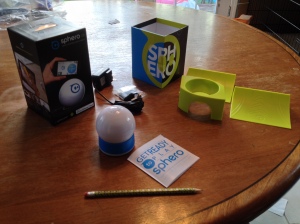Robot Basics:
- What is it?
- What’s in the box?
This package comes with 2 manuals with over 300 projects to build. It also comes with 60 components.
- How much is it?
The cost of this package is around $45.00. You can get additional packages for more or less.
- How did we acquire it?
My library purchased three kits for use in programs.
Ideas for Use
I used these kits in my Robot Test Lab programs. Many kids were already familiar with the snap circuit kits. They had them at home, or knew of friends who had them. I paired two kids together per kit to attempt to put together a project listed in the manual.
Time Involved
This program takes no time to prepare. I played with the kits a bit before I put them out. I enjoyed figuring out how to build an AM radio. Building a project from the manual can take anywhere from 10 minutes to a half hour.
One-time or Recurring Program
This could be an on going program, however I found that most of the kids already knew how to use the Snap Circuit kits. They were more interested in creating new projects and not following the directions.
Extension Activities
You could use these kits in a variety of ways. The students could be challenged to build the same project in the shortest amount of time. The students could create an entire new project using the three boards as opposed to just the one in the kit. Many of the kids I worked with were enthusiastic to see what they could come up with. They were quickly bored by the directions from the book. Once they understand the concept of circuitry, they can do many things.
Skills You Need
The ability to read directions and then, the ability to do your own thing.
Other Tools You Need
4 AA batteries
Good Stuff
I love this kit. As someone who gets nervous around STEM theories and programs, this is something I found interesting and manageable. I spent a bit of time building my own Snap Circuit AM Radio and when it finally came together and worked, I felt proud.
Frustrations
I wish the kids would think outside of the box a little more often. Many of them wanted to create their own circuit but did not understand the basics of circuitry before starting their own projects. Of course, this could be my own problem. I want kids to understand what they are doing before they start branching out. I forget that the point of all of this is to experiment.
Ending Thoughts/Observations
I used these kits with middle school kids. I think they could best be used with elementary age. The middle school kids were bored more easily. Many of them had used the kits before at home. If you can get started with a younger group, you may have more luck with keeping their attention for a longer period of time.
Overall Rating:
I think these kits are a great deal. They are wonderful for those of us who still feel a little squeamish around robotics and STEM programming.



